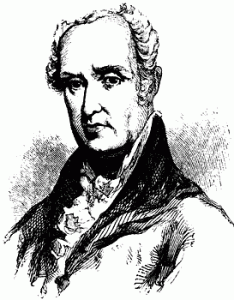
Col John Armstrong - Source: http://freepages.genealogy.rootsweb. ancestry.com/~scanderson/ john_armstrong.HTM
One connection that Colonel John Armstrong had to the Black Boys Rebellion that is often forgotten is that he built Fort Loudoun in 1756. It is quite likely Armstong built the fort on the Patton Farm located outside of the town of Fort Loudoun, Pennsylvania because it provided a defensive advantage and was in close proximity to a road for supply and reinforcement.
Armstrong was born in Brookborough Parish County Fernanagh, Ireland in 1717. At the age of 26 he came to America and settled in Cumberland County Pennsylvania. He began work as a surveyor.
At the formation of Pennsylvania’s militia units for the French and Indian War in 1755 Armstrong was elected one of two officers and commanded 1400 men.
He rose to the rank of captain in 1756 and was promoted to Lt. Col. in May of 1757. He is best remembered for leading 300 men against Kittanning which was then a Delaware tribe stronghold on the Allegheny river.
In 1758 Armstrong fought with Col. Henry Bouquet in the Forbes expedition that captured Fort Duquesne, the French stronghold in present day Pittsburg. When the French and Indian War ended he returned to Carlisle and went back to surveying. In both the Paxton Boys uprising and Smith’s Rebellion, Armstrong walked a political tightrope. He was well connected with members of the provincial government and the Penns. It is widely believed that he was more than sympathetic to the Paxton Boys in 1763 and quite possibly the Black Boys in 1765 despite some public denunciation of the Black Boys before the Penns.
Armstrong was among 250 Paxton men who marched in Philadelphia in January 1764 to protest the government protection of Indians. Because of his surveying in and around the Fort Loudoun area it is quite likely that Armstrong knew many of the Black Boys as well. Armstrong, like Smith, was a Cumberland County magistrate during the time of Smith’s Rebellion. Armstrong took William Smith’s deposition in Governor John Penn’s investigation of the Sideling Hill affair on April 3, 1765.
Armstrong died in 1795. At his death he was one of the first trustees of Dickinson College in Carlisle, Pennsylvania.
Sources:
Peaceable Kingdom Lost, The Paxton Boys and the Destruction of William Penn’s Holy Experiment. Kenny, Kevin. Oxford University Press. NY, NY. 2009
Chapter V: Race: The Permanent Pennsylvania Frontier, 1763 – 1768 in Creating Pennsylvania: The Politics of the Frontier and the State 1682 – 1800. Spero, Patrick. Ph.D. dissertation, University of Pennsylvania. 2009
The Paxton Boys. from Wikipedia. http://en.wikipedia.org/wiki/Paxton_Boys
Historical Sketch of Armstrong County Part VI. http://www.pa-roots.com/armstrong/smithproject/history/chap1f.html
The Paxton Boys and the Pamphlet Frenzy: Politics, Religion and Social Structure in 18th Century Pennsylvania. Mancini, Alexandra http://www.publications.villanova.edu/Concept/2007/07_papers_ html/Mancini-PaxtonBoy